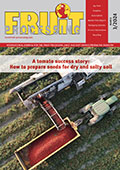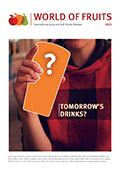The Brazilian orange crop for 2019/20 (MY 2018/19) is projected at 494 million boxes, a 26 percent increase vis-a-vis the previous season. Citrus trees are vegetatively recovered from the previous year and weather conditions supported good blossoming, fruit setting and development. Total frozen concentrate orange juice (FCOJ) production is forecast at 1.397 mmt, a sharp increase in relation to the previous year (1.004 mmt) due to expected higher fruit availability for crushing. Cumulative orange juice exports to the United States during the July 2018 – May 2019 cycle are reported at 185,000 mmt of FCOJ equivalent, significantly down from the previous cycle (302 mmt FCOJ equivalent), due to the recovery of the crop in Florida. FCOJ ending stocks are projected at 240,000 mt, 65 Brix, an increase of 140,000 mt compared to MY 2017/18, due to projected higher juice availability.
Read the complete report
The 2018-2019 orange crop forecast update for São Paulo and West-Southwest Minas Gerais citrus belt, published on September 10, 2018 by Fundecitrus – performed in cooperation with Markestrat, FEA-RP/USP and FCAV/Unesp2 – is of 273.34 million boxes of 40.8 kg each. This figure corresponds to a decrease of 5.19 % in relation to the estimate published in May/2018. Approximately 15.37 million boxes of the total crop should be produced in the Triângulo Mineiro.
Fruit of all varieties harvested up to August presented average weight below the May/2018 forecast. Smaller fruit resulted from a more severe drought than expected for May to July at the time of the estimate. Rainfall in that period is directly related to fruit development and consequently to final fruit weight at harvest. Climatological expectations at that time pointed to a less rainy year, with an accumulated average rainfall for those months of approximately 101 millimeters for the citrus belt, which is 24 % below historical average (1981-2010). However, the actual accumulated rainfall volume for that period was 36 millimeters, 73 % below historical average, characterizing the worst drought in the ten assessed years. More significant rain above historical average only fell in August in the South, Southwest and most of Central regions, with an average of 103 millimeters, whereas for the remainder of the citrus belt the average rainfall for that month was 38 millimeters.
Harvest reached 93 % completion for the early Hamlin, Westin and Rubi varieties, and 75 % for other earlies. Harvest totaled 29 % for the Pera variety, 15 % for the Valencia and Valencia Folha Murcha varieties, and 10 % for the Natal variety. Approximately 36 % of the total 2018-2019 crop was harvested. At the same time last crop season, harvest was 34 % complete. The main difference between the two crop seasons is that the current harvest progressed faster to late varieties. That indicates the crop season will finish earlier. Although the harvest of the Pera and late varieties is still in early stages, it is already necessary to adjust fruit size due to the water deficit that affected full development …
Please download the full update.
After the large output in 2017/18, supply may be limited again in the 2018/19 season in São Paulo State and Triângulo Mineiro. With unfavorable weather during the fruitlet settlement in the first flowering event (the main event), which would become fruits in the next season, losses were observed in three of the four main citrus producing regions in São Paulo.
Northern and central SP should be the most affected, followed by the eastern region of the state. In southwestern SP, however, fruitlet drops in the first flowering event were within normality. Thus, once again, productivity in this area may be high again.
With signs of new flowering events at the end of the year, losses may be softened if settlement is satisfactory. Still, the volume of fruits should be smaller than that from the main event.
The first USDA report for the next Brazilian orange crop, released in December, indicate an output of 320 million boxes of 40.8 kilos in 2018/19 in São Paulo State and Triângulo Mineiro, 19 % lower than in 2017/18. Although it is still early to measure, growers consulted by Cepea believe in an even lower output. The first estimates from Fundecitrus (Citrus Defense Fund), in turn, should be released in May.
Despite forecasts for lower supply of raw material in 2018/19, 93 % recovery of orange juice inventories at processors from São Paulo in June 2018 does not indicate excess in juice supply yet. The large crop will be enough only to replenish low inventories from 2016/17.
Besides, agents should be watchful for lower production in Florida as well. According to the last report released by the USDA (in December), harvesting in Florida should total only 46 million boxes, 33 % down compared to the previous season. In addition to greening, which has affected local production for some crops, hurricane Irma hit the area in September 2017. Local production results will be released in July 2018. Thus, as inventories decrease in the United States, there is need for more importation.
PURCHASES – The first orange purchase proposals in the 2018/19 season were reported in the market of São Paulo in mid-November, 2017. Although occasional, large-sized processors have signaled possible trades around 20.00 BRL per 40.8-kilo box, harvested and delivered at the processor, with participation additional in juice sales prices in the international market. If a larger volume is purchased – or for a period longer than two years –, bids at 22.00 BRL per box have been reported.
However, based on expectations for a smaller crop, citrus growers are cautious regarding closing new contracts, and many of them are monitoring price rises. The values initially bid by the industry are higher than in the spot market this crop, but lower than in the 2016/17 season, when supply was low.
TAHITI LIME – Tahiti lime harvest in 2018 is forecast to be smaller as well. According to Cepea collaborators, besides losses of part of the flowers (due to warm and dry weather), many small-sized fruits were harvested in November and December, which should be ready to be harvested now in January.
The tahiti lime crop peak is forecast for January, since rains in late December and early January may have favored the development and growth of fruits. Thus, prices are expected to remain at low levels until late March, pressed down by higher supply. On the other hand, exportations are expected to increase, as well as the volume of fruits sent to processors.
The harvesting of the early oranges in the 2017/18 season is slowing down in some citrus producing regions from São Paulo, mainly in cities with higher temperatures (where fruits mature faster). The last fruits to be collected, therefore, should be harvested until late August, according to Cepea collaborators.
According to Fundecitrus (Citrus Defense Fund), the citrus belt should harvest 364.47 million boxes in 2017/18, volume 50 % larger compared to that in the previous season. Of this total, 68.5 million would account for early oranges (+ 42 %).
In late July, the deliveries of pear oranges purchased through contracts intensified in the main processors from SP, according to growers. That reflected on the price averages of fruits in the spot market. In July, early orange quotes averaged 18.32 BRL per 40.8-kilo box, 6 % up compared to the average in June; pear oranges prices, in turn, averaged 18.55 BRL per box in July, 15.2 % up in the same comparison – both values only include expenses with harvesting and freight to the processing plant.
Pear orange harvesting, however, should step up in August, as the supply of early oranges decreases. Regarding late oranges, mainly valencia and natal, the first volumes should be available only in September.
Purchases of pear oranges were occasional in July. In the first fortnight of the month, some pear orange trades reached 20.00 BRL per box, depending on the quality and ratio of the fruit supplied, regarding the standard demanded by processors.
According to agents from processors, early orange crushing should keep firm in August, in order to focus on pear oranges, in September. Thus, the gradual increase of pear oranges in crushing this month, added to the back to school period, may reduce the availability of the fruit in the in natura market, pushing up quotes.
Regarding the in natura market, not even the warmer weather favored demand for pear oranges in late July. Besides, supply of fruits with lower quality than that demanded by the segment increased as well. Last month, pear orange quotes averaged 16.17 BRL per 40.8-kilo box, on tree, 6 % down compared to that in June.









